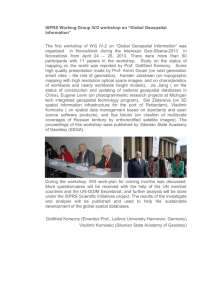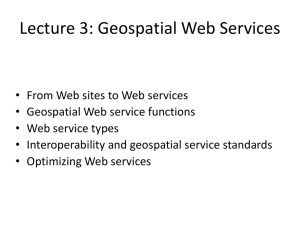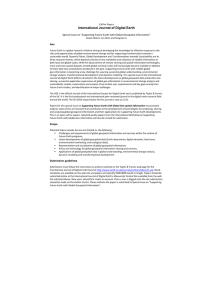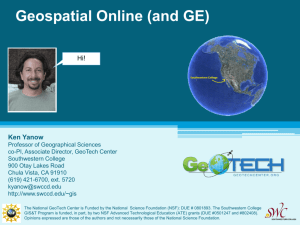INTEROPERABLE ANTSDI-THE GEOSPATIAL INFORMATION GATEWAY TO ANTARCTICA: ARCHITECTURE AND APPLICATION
advertisement
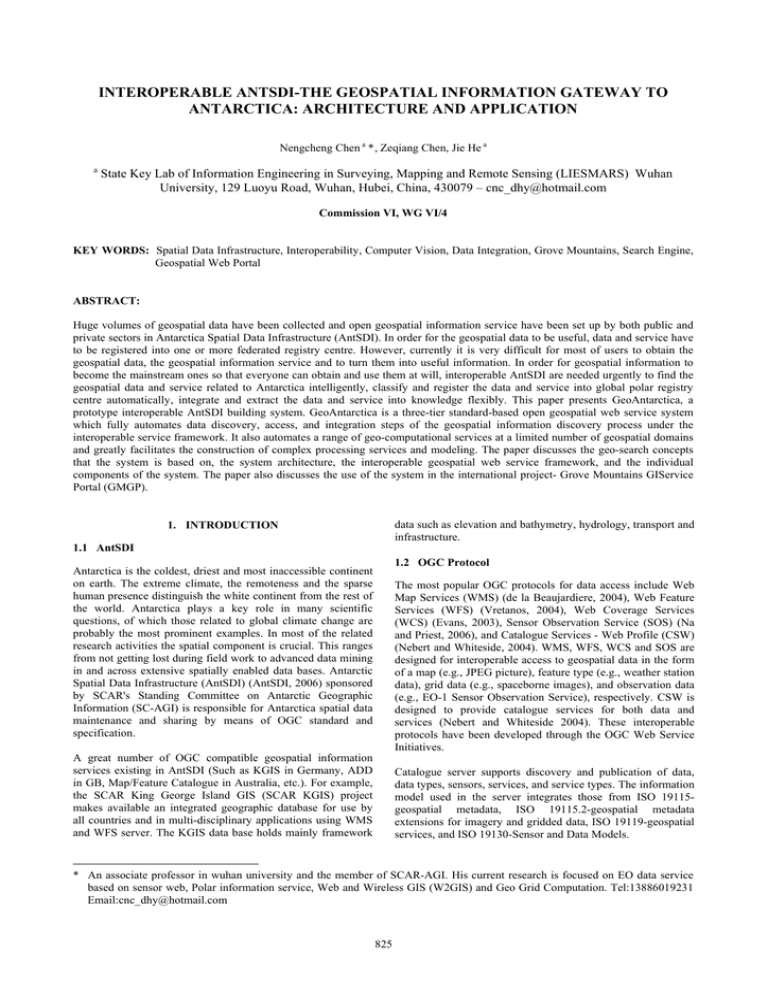
INTEROPERABLE ANTSDI-THE GEOSPATIAL INFORMATION GATEWAY TO ANTARCTICA: ARCHITECTURE AND APPLICATION Nengcheng Chen a *, Zeqiang Chen, Jie He a a State Key Lab of Information Engineering in Surveying, Mapping and Remote Sensing (LIESMARS) Wuhan University, 129 Luoyu Road, Wuhan, Hubei, China, 430079 – cnc_dhy@hotmail.com Commission VI, WG VI/4 KEY WORDS: Spatial Data Infrastructure, Interoperability, Computer Vision, Data Integration, Grove Mountains, Search Engine, Geospatial Web Portal ABSTRACT: Huge volumes of geospatial data have been collected and open geospatial information service have been set up by both public and private sectors in Antarctica Spatial Data Infrastructure (AntSDI). In order for the geospatial data to be useful, data and service have to be registered into one or more federated registry centre. However, currently it is very difficult for most of users to obtain the geospatial data, the geospatial information service and to turn them into useful information. In order for geospatial information to become the mainstream ones so that everyone can obtain and use them at will, interoperable AntSDI are needed urgently to find the geospatial data and service related to Antarctica intelligently, classify and register the data and service into global polar registry centre automatically, integrate and extract the data and service into knowledge flexibly. This paper presents GeoAntarctica, a prototype interoperable AntSDI building system. GeoAntarctica is a three-tier standard-based open geospatial web service system which fully automates data discovery, access, and integration steps of the geospatial information discovery process under the interoperable service framework. It also automates a range of geo-computational services at a limited number of geospatial domains and greatly facilitates the construction of complex processing services and modeling. The paper discusses the geo-search concepts that the system is based on, the system architecture, the interoperable geospatial web service framework, and the individual components of the system. The paper also discusses the use of the system in the international project- Grove Mountains GIService Portal (GMGP). data such as elevation and bathymetry, hydrology, transport and infrastructure. 1. INTRODUCTION 1.1 AntSDI 1.2 OGC Protocol Antarctica is the coldest, driest and most inaccessible continent on earth. The extreme climate, the remoteness and the sparse human presence distinguish the white continent from the rest of the world. Antarctica plays a key role in many scientific questions, of which those related to global climate change are probably the most prominent examples. In most of the related research activities the spatial component is crucial. This ranges from not getting lost during field work to advanced data mining in and across extensive spatially enabled data bases. Antarctic Spatial Data Infrastructure (AntSDI) (AntSDI, 2006) sponsored by SCAR's Standing Committee on Antarctic Geographic Information (SC-AGI) is responsible for Antarctica spatial data maintenance and sharing by means of OGC standard and specification. The most popular OGC protocols for data access include Web Map Services (WMS) (de la Beaujardiere, 2004), Web Feature Services (WFS) (Vretanos, 2004), Web Coverage Services (WCS) (Evans, 2003), Sensor Observation Service (SOS) (Na and Priest, 2006), and Catalogue Services - Web Profile (CSW) (Nebert and Whiteside, 2004). WMS, WFS, WCS and SOS are designed for interoperable access to geospatial data in the form of a map (e.g., JPEG picture), feature type (e.g., weather station data), grid data (e.g., spaceborne images), and observation data (e.g., EO-1 Sensor Observation Service), respectively. CSW is designed to provide catalogue services for both data and services (Nebert and Whiteside 2004). These interoperable protocols have been developed through the OGC Web Service Initiatives. A great number of OGC compatible geospatial information services existing in AntSDI (Such as KGIS in Germany, ADD in GB, Map/Feature Catalogue in Australia, etc.). For example, the SCAR King George Island GIS (SCAR KGIS) project makes available an integrated geographic database for use by all countries and in multi-disciplinary applications using WMS and WFS server. The KGIS data base holds mainly framework Catalogue server supports discovery and publication of data, data types, sensors, services, and service types. The information model used in the server integrates those from ISO 19115geospatial metadata, ISO 19115.2-geospatial metadata extensions for imagery and gridded data, ISO 19119-geospatial services, and ISO 19130-Sensor and Data Models. * An associate professor in wuhan university and the member of SCAR-AGI. His current research is focused on EO data service based on sensor web, Polar information service, Web and Wireless GIS (W2GIS) and Geo Grid Computation. Tel:13886019231 Email:cnc_dhy@hotmail.com 825 The International Archives of the Photogrammetry, Remote Sensing and Spatial Information Sciences. Vol. XXXVII. Part B8. Beijing 2008 2. INTEROPERABLE ANTSDI 1.3 Geospatial search engine 2.1 Concept The term, “ontology,” originates from the field of philosophy as a reference to the nature and the organization of reality; it is a “specification of a conceptualization” (Gruber, 1993). To provide formal semantic descriptions of NASA data and scientific concepts, several projects are underway to develop a semantic framework. Described in the OWL language, the ontology within the Semantic Web for Earth and Environmental Terminology (SWEET) (Raskin,2006) contains several thousand terms spanning a broad extent of Earth system science and related concepts (such as NASA GCMD, ESML, ESMF, grid computing, and OGC). The SWEET provides a high-level semantic description of Earth system science. The ontology of geographic information metadata (ISO 19115 and FGDC) (Islam et al, 2003) may provide semantic context to the data description through its explicit association with providers, instruments, sensors and disciplines, and the relationships across these concepts. The goal of interoperable AntSDI is to solve the above problems by developing a next generation Polar geospatial information service system, called GeoAntarctica. It is an open, interoperable, distributed, standard-compliant, multi-node, multi-tier web-based Polar geospatial information services and processing service sharing system. At the back-end, the system will access the multi-PetaBytes of Antarctica spatial data at multi-node data pools running at JCADM (Joint Committee on Antarctica Data Management) (JCADM, 2006) Antarctic data directory system, ADD (Antarctica Digital Database), AAD (Australian Antarctica Database), CACSM (Chinese Antarctica Centre of Surveying and Mapping) spatial database, USGS (United State Geology and Survey) Antarctica database, NSIDC (National Snow and Ice Data Centre) and etc. At the front-end, end-users are able to find and obtain data in the form that exactly matches their requirements so that the data are ready for analysis. In addition to obtaining the data with great easiness, the system also provided an interoperability framework allowing end-users to develop individual geospatial web-service modules and to use these modules and those provided by GeoAntarctica for constructing complex web-executable geospatial models. By executing the models on the system online against any subsets of the petabytes of Antarctica data in the data pools, end-users obtain not the raw data but solutions to their scientific questions. The user developed modules and models can be plugged into the system to become its operational capabilities. To other end-users, the newly available web-executable models represent the types of geospatial products available at the system although the products will only be produced when users request them. These models and modules can be reused to construct even more complicated geospatial models. This accumulation of knowledge through sharing and reuse of geospatial process models will make the system evolvable and increasingly capable with time. The framework also makes the idea of interoperable systems developed by a community for the community a reality. In (Peisheng et al,2006; Liping et al,2006), Geospatial data mining ontology oriented toward the research themes in NASA Earth-Sun system is put forward. However, the mapping between the geospatial information service metadata ontology is still in investigation. In particular, the definition of ontology for geospatial information services has not been adopted. In (Yuqi et al, 2004), a spatial data search engine “CIHU” is implemented, that locates raster pictures based on place name. Google recently introduced a demonstration of location based web search engine in the USA. Like the Vicinity search tools, it allows the user to specify the name of a place of interest using an address or zip code, which is then matched against relevant documents. 1.4 Problems Construction of AntSDI faces the following difficulties: on the one side, too much information and service created by many heterogeneous, distributed sources is very difficult to manage; on the other side, user can’t get the enough spatial knowledge from the diverse information and service. Interoperable AntSDI are needed urgently to find the geospatial data and service related to Antarctica intelligently, classify and register the data and service into global polar registry centre automatically, integrate and extract the data and service into system flexibly. 2.2 Architecture Figure 1 shows the GeoAntarctica architecture. As shown in the figure, GeoAntarctica is built upon the open, consensus based standards that will allow other foreign systems to interoperate with it through standard interfaces. GeoAntarctica is a three-tier system that includes the interoperable data server tier, the middleware geospatial processing service tier, and the integrated geoinformation client tier. In the system, GPGRC (Global Polar Geospatial Registry Centre), MNGIPS (Multi Nodes Geospatial Integration and Process Service) and GPGISP (Global Polar Geospatial Information Service Portal) are the three key components. The observation, data, process and presentation are the four kinds of nodes. 1.5 Organization This paper mainly deals with the above issues and tries to explain how to use OGC standard to discover, integrate and process the multi-nodes Antarctica spatial data. The concept, architecture, and the main components of the system are described in section 2. Detailed information about the Polar geospatial data search engine is discussed in section 3, it can be used discover and retrieve the Antarctica spatial data. Section 4 discusses how to register Antarctica spatial data, service and process using ebRIM CSW. A multi-protocol integration and processing of OGC complaint web portal is presented in section 5. The use of the system in the international project- Grove Mountains GIService Portal (GMGP) is discussed in section 6. Finally, section 7 summarizes the conclusions and discusses the next steps that are needed. . GPGRC supports the registry and discovery of services, datasets, coverages, features, and service chain. It retrieves and registers metadata with four core operations: GetCapabilities, GetRecords, DescribeRecords, and HarvestRecords. The external interface follows the OGC CSW2.0 standard, which supports three types of interface: OGC_Service, Discovery, and Manager. The OGC_Service interface is the getCapabilities operation, providing a description of the capabilities for catalogue service and also providing related XML documents. The Discovery interface provides three operations by which 826 The International Archives of the Photogrammetry, Remote Sensing and Spatial Information Sciences. Vol. XXXVII. Part B8. Beijing 2008 Service (WPS). 3) Distributed heterogeneous data sources: For sensor data services, Web Feature Service (WFS) and Web Coverage Service (WCS) are used to discover and retrieve feature type data (for example, weather station data), Grid coverage data (for example, aerial images) and Earth scientific data. For Sensor Web data sources, the sensor observation service is adopted to retrieve observations and measurements encoded using O&M specification. Multiple versions of the data services, such as WFS 1.0.0, WFS 1.1.0, WCS 1.0.0, and WCS 1.1.0 can be discovered and retrieved. 4) High scalability: Service parts, service operations, and data sources can be chosen and extended by user requirements. Thus, the system can achieve flexible deployment. clients can discover and obtain the information registered in the catalogue service database. The Manager interface allows users to use the “push” or “pull” mode to update catalogue content. 3. GEOSPATIAL SEARCH ENGINE 3.1 OWS service crawl and detection The geospatial service search engine is designed and implemented to find the coarse service from World Wide Web (WWW), the ontology reasoning is designed to find the refined service from the coarse service. It is the core component in the GPGRC and responsible for the URL link crawl and OWS service detection through processing of OWS service capabilities and content matching. Service metadata includes information of the service provider, service operation, and service content. Figure 1 Interoperable GeoAntarctica architecture MNGIPS is a series of Web Processing Service (WPS) defined in (Schut and Whiteside, 2005) and provides client access to pre-programmed calculations and/or computation models that operate on spatially referenced data. The calculation can be as simple as subtracting one set of spatially referenced numbers from another, or as complicated as a global climate change model. For manipulating and analyzing vector and raster geospatial data, GeoAntarctica provides more than 50 built-in WPSs. Users can use these services to analyze and mine data from any OGC-compliant online data sources. Moreover, the GeoAntarctica is open and fully extensible. It allows users to integrate their own WPS to do online analysis. The information flow of OWS service search is described as: 1) Open source search engine, “Nutch” was used to traverse links on web pages and generate a URL database. The indexer uses the content to generate an inverted index of all terms and all pages; 2)The document set is divided into a set of index segments, each of which is fed to a single searcher process; The strings “WMS”, “WFS” and “WCS” are parsed as keywords to query the indexed web content; 3) An OGC “getCapabilities” request is sent to the identified “WMS”, “WFS” and “WCS” service URL links and the service parameters are processed from the response. GPGISP is a multi-protocol OWS service portal based on the common interface and was implemented to support multiple types of geospatial web services (WMS, WFS, WCS) from different implementers supporting the OGC specifications. A portal is a powerful Web site that gives users a single point of access to applications and information in a unified interface. A portal lets users view each application or Web page in its own window, called a portlet, and a single browser window can contain multiple portlets. The portlet based on JSP168&WSRP is a new technology for interactive, user-facing web services that plug and play with portals. In this paper, Protégé 3.1 was used to construct geospatial service ontology. Protégé can import and export the ontology in XML, RDF(S) and XML Schema representations, after installing a plug-in. It also supports DAML+OIL and the Web Ontology Language, OWL. Once populated, the geospatial service ontology enables automatic discovery, invocation and composition of all registered services conforming to the OWL-S specification. The “profile” of OWL-S describes who provides the service, what the service does, as well as other properties of services, and uses the knowledgebase to infer whether or not a particular service is appropriate to a given problem. The “process model” of OWL-S declares the inputs, outputs, preconditions, and effects of a service, and uses the knowledgebase to figure out whether or not a service meets the requirements and conditions to invoke the service. 2.3 Characteristics The GeoAntarctica has the following features. 1) Service-Oriented System: Both the observational data and value-added processing services use service-oriented architecture. The entire process is implemented by plug-andplay components, can be packaged into Web services, and achieved better performance by the service components optimum combination. 2) Interoperability: The observational data services, processing services, value-added services, and customer can interoperate through multi-level standard interface protocols. For example, the client or the user queries distributed heterogeneous data sources through Catalogue Service - Web profile (CSW), accesses the data through the Web Coverage Service (WCS), and execute clipping operation through the Web Process 3.2 Antarctica OWS service ontology generation The OWS ontology tree includes classifications of Portrayal Service, Data Service, Process Service and Discovery Service. Data Service includes Web Feature Service (WFS), Web Coverage Service (WCS), Sensor Collection Service (SOS) and Image Archive Service (IAS). Besides, we can reuse the Antarctica place name ontology developed by Italy. 827 The International Archives of the Photogrammetry, Remote Sensing and Spatial Information Sciences. Vol. XXXVII. Part B8. Beijing 2008 “xAxisName”, “yAxisName”, “originPoint”, “xResolution”, “yResolution”, “requestCRSs”, “responseCRSs”, “nativeCRSs”, “supportedFormats”, “nativeFormat” and “BBOX” elements. Since all of the ontology is represented by OWL, the inference engine in the prototype is an OWL reasoner built on Prolog. Ontological information written in OWL or OWL-S is converted into RDF triples and loaded into the Prototype. The engine has built-in axioms for OWL inference rules. These axioms are applied to facts in the prototype to find all relevant entailments such as the inheritance relation between classes that may be not directly revealed in the subclass relationships. An Antarctica domain OWS instance is generated and shown in figure 2. 4.2 Implementation The global polar geospatial information registry centre is designed and implement by a distributed CSW services. The distributed CSW services are in charge of not only discovering and managing distributed earth observation services, datasets, coverages, features and service chains, but also the coordination of multiple CSW services. The upper CSW harvest the record information from the lower CSWs by “HarvestRecord” interface. The single CSW server is implemented by the three kinds of known external interface. The external interface, consisting of three types, OGC_Service, Discovery, and Manager, follows the OGC CSW 2.0 standard. The OGC_Service interface consists of the “GetCapabilities” operation, providing a description of the capabilities of the catalogue service, and related XML documents. The Discovery interface provides three operations that allow clients to discover and obtain the information registered in catalogue service database. The Manager interface allows users to use “push” or “pull” mode, in order to implement the update of catalogue content. The CSW registry was implemented using java and MySQL database. A polar spatial information service registry centre was constructed in Chinese Polar spatial information portal to access the distributed Antarctica geospatial data and service. Figure 2. Antarctica domain OWS instance 5. MULTI PROTOCOL INTERGRATION WEB PORTAL 4. GLOBAL POLAR GEOSPATIAL INFORMATION REGISTRY CENTRE 5.1 Web Portal 4.1 Content The OWS service information would be bundled into a “ServiceType” object or “DataType” object. “ServiceType” provides minimal metadata for registry OGC service. The “Service” object includes “id”, “home”, “objectType”, “status”, “expiration”, “majorVersion”, “minorVersion”, “stability” and “userVersion” attributes, and “name”, “description”, “slot”, “classification”, “externalIndentification” and “serviceBinding” elements. The “Slot” instances provide a dynamic way to add arbitrary attributes to a registry service object. The “classification” element defines a tree structure to describe a structured way for classifying or categorizing “RegistryObject”s. The new attributes such as “version”, ‘keyword”, “connectPointLinkage”, “wsdlURL” are added to the “ServiceType” object through Slots. “DataType” provides minimal metadata for registry coverage data, meanwhile, an “Association” object uses an “associationType” attribute to identify the relationship between a source “DataType” object and a target “Service” object, so that the “DataType” data can be served through the specified OWS server. The “DataType” object includes not only “id”, “home”, “objectType”, “status”, “expiration”, “majorVersion”, “minorVersion”, “stability”, “userVersion”, “mimeType” and “isOpaque” attributes but also “name”, “description”, “slot”, “classification”, “externalIndentification”, “granule”, “version”, “name”, “label”, “gridEnvelopLow”, “gridEnvelopHigh”, 828 A portal is a powerful Web site that gives users a single point of access to applications and information in a unified interface. It may be one of the applications which held by portal server. Generally speaking, portal support the content aggregation from multi individual site, single sign on, and trustee the representations layers of different back system. The main task of portal is to gather different applications in a page whose look is shared by portal users. Portal also have complex individual characteristic that support users to custom content. Generally, portal has three characters as follow: z z z Personalization. Portal can be used to customize userdefined interface. Single sign on. Use can access the global information using a unified log in interface. Content aggregation. Information from multi web sites can be displayed in the same page. Users can do some commercial applications more convenient and faster. In the sight of the final users, portal is a Web site. The portal page presents as page tabs, drop-down menus, or other navigation mechanisms. Every page contains sub-pages, one or muti portlets which show the static HTML content and complex Web Service content etc. Thank to this, users can easily access the different information and tools. Furthermore, users can custom the portal view through adding user-defined pages and necessary portlets, then change the look. Portlet is a JAVA technology based on Web component. Portlet can be manged, processed and generated page dynamically by The International Archives of the Photogrammetry, Remote Sensing and Spatial Information Sciences. Vol. XXXVII. Part B8. Beijing 2008 portal. Firstly, GPS control point database, topographic database, satellite imagery database and DEM database of this Grove mountains are set up using Oracle9i database, and these databases are served through WCS and WFS customized by GeoSurf, an Internet GIS software developed by state key lab of Information Engineering in Surveying, Mapping and Remote Sensing; Secondly, we use the geospatial search engine to find the large scale vector data from UK’s ADDI WFS data server and Italy’s place name data server; Thirdly, the above WFS and WCS services are registered as “ServiceType” and the place data is registered as “DataType” in GPGRC deployed in Chinese Antarctica centre of surveying and mapping at wuhan university. Once the user will get the full map of Antarctica, the system will transfer the request to geospatial web portal, the UK’s ADDI WFS data server and Italy’s place name data would be found in GPGRC by “GetRecords” request, and the service address and pace name data will be returned to geospatial web portal. The geospatial web portal invokes the WFS “GetFeature” to get the contour line, coast line and lake polygon data. The geospatial web portal invokes the Web Transform Service (WTS) and WMS deployed in LIESMARS to finish the ingestion of Full Antarctica map (see figure 3)and Grove mountains geospatial information portal (see figure 4). In the Grove mountains geospatial information portal, user can query detail information. portlet container. They can plug and play with Portal as UI components. Portlet container manages the lifecycle of portlet and supply the necessary running environment. Portlet can be added, deleted, maximized, minimized and edited. More and more companies, such as Bea, IBM and Oracle have been developed their Portal components and products based on the portlet technology. The Java Community Process (JCP) published the portlet specification-Java Specification Request (JSP168). The JSP168 can resolve the incompatibility problems among the different Portal and portlets. Web Service for Remote Portal (WSRP) is a standard defined by Organization for the Advancement of Structured Information Standards (OASIS). WSRP defines a set of interfaces and related semantics which standardize interactions with components providing user-facing markup, including the processing of user interactions with that markup. This allows applications to consume such components as providing a portion of the overall user application without having to write unique code for interacting with each component. It is mainly used to simplify the complexity of the diversity Web Portal. 5.2 Geospatial Web Portal A multi-protocol OWS service portal based on the common interface was implemented to support multiple types of geospatial web services (WMS, WFS, WCS, WPS) from different implementers supporting the OGC specifications. Through the portal, international polar spatial information services can be published, registered, found, invoked, and integrated. Users can use the portal to find and access distributed polar spatial data through any compatible registered services; these include services from the Chinese polar spatial database using WMS and WFS, the Canadian cyber atlas of Antarctica using WMS, the German King George Island spatial data using WMS and WFS, UK’s ADDI data using WFS, the Australian Antarctic Data Centre holdings using WMS, and the USA’s USGS polar database using WMS, among others. 6. APPLICATION IN GMGP Figure3. Full Antarctica map from multi node WFS 6.1 Goal Grove Mountains located in south Antarctic and could help to resolve many important scientific problems because of their natural and unique geological landforms. How to manage the information resource in this area, however, has become a serious problem. In order to protect particular scientific, aesthetic and wildness value in this area, our country has proposed the establishment of Antarctic Grove Mountains GIService Portal (GMGP) to reserve the nature resource. The GMGP is an international cooperation project in SCAR AGI sponsored by China. The main goal is to set up GPS control point database, topographic database, satellite imagery database and DEM database of this area; construct the Grove Mountains GI web service Portal and serve for Antarctic expedition management. 6.2 Implementation In the GMGP project, we use the proposed interoperable AntSDI to construct Grove mountains geospatial information Figure 4.Grove mountains geospatial information portal base on WFS and WMS 829 The International Archives of the Photogrammetry, Remote Sensing and Spatial Information Sciences. Vol. XXXVII. Part B8. Beijing 2008 7. CONCLUSIONS AND OUTLOOK To develop an AntSDI that can harmonize diverse data node, support heterogeneous service node and meet different personalized requirements of users is a great challenge. This paper proposes an interoperable AntSDI to discover, integrate, process and assimilate geospatial data and process using OGC standard interface and service middleware technology. The proposed method was successfully tested in the construction of GMGP. The approach overcomes problems discussed in section 1.4 and plagues existing AntSDI implementations. The new approach has six advantages than the existing AntSDI implementation: (1) A flexible GeoAntarctica architecture. The strategy adopts service-oriented architecture to package the component. This service can be independently deployed with service middleware; (2) The better precision of “OGC Service” retrieval, the “OGC Service” aware search engine use the “detection” to discover the potential service, the effective hits number of “detection” strategy is 10 times than that of the traditional search engine; (3) Service instance can be automatically generated through service capability and ontology reasoning. It is confident that the mature “OGC service” aware search engine will play more and more important role in the high OGC service retrieval. (4) The global polar geospatial information registry centre adopted an ebRIM based CSW service to discover and manage distributed earth observation services, datasets, coverages, features and service chains as uniform “ServiceType” or “DataType”. (5) A multi-protocol OWS service portal based on the common interface can be used to support multiple types of geospatial web services (WMS, WFS, WCS, WPS) from different implementers supporting the OGC specifications. (6)Through the interoperable AntSDI, geospatial data and process service can be discovered, published, stored, managed and served on-demand. Fonseca F., Egenhofer M., Davis C., and Camara G (2002),Sematic Granularity in Ontology-Driven Geographic Information Systems, Annals of Mathematics and Artificial Intelligence,Vol.36, No.1-2:121~151, 2002. JCADM., 2006. International Polar Year 2007-2008 Data Policy. http://www.jcadm.scar.org/fileadmin/documents/ data_ manag_ policies/ipy_data_policy.pdf. (accessed 28 Jan. 2008). Gruber T. , 1993. A translation approach to portable ontologies, Knowledge Acquisition, Vol. 5, Issue 2, 1993, pp. 199-220. Islam, L. Bermudez, B. Beran, S. Fellah, M. Piasecki (2003), Ontology for Geographic Information – Metadata. http://loki.cae.drexel.edu/~wbs/ontology/iso-19115.htm. (accessed 28 Jan. 2008) Na A., Priest M. (Eds.), 2006. OpenGIS® Sensor Observation Service Implementation Specification (Version 0.1.5). OGC Document Number: 06-009r1, 187pp. Nebert, D., Whiteside, A. (Eds.), 2005. OGC™ Catalogue Services Specification (Version 2.0.0). OGC Document Number: 04-021r3, 187pp. Peisheng Zhao., Liping Di., 2006. Semantic Web Service Based Geospatial Knowledge Discovery. In : Proceedings of 2006 IEEE International Geoscience And Remote Sensing Symposium. July 31- August 04, 2006. Denver, Colorado, USA. Raskin R., 2006. Enabling Semantic Interoperability for Earth Science Data. http://sweet.jpl.nasa.gov/Enabling Final.doc. (accessed 28 Jan. 2008) Schut P., Whiteside A., 2005. OpenGIS® Web Processing Service. OpenGIS Project Document: OGC 05-007r4, Open GIS Consortium. Yuqi Bai., Chongjun Yang., 2004. Research on Spatial Information Search Engine, Journal of China University of Mining and Technology, Vol.33, No.1:90~94. The next step is to study how to use Sensor Web technology to provide self-adaptive Antarctica geospatial data service by harmonizing SOS, SPS, WCS, WFS, WMS and Web Processing Service (WPS). Voges, U., Senkler, K. (Eds.), 2005. OpenGIS® Catalogue Services Specification 2.0—ISO19115/ISO19119 Application Profile for CSW 2.0 (Version 0.9.3). OGC Document Number: 04-038r2, 89pp. REFERENCES AntSDI., 2006. What’s AntSDI. http://www.antsdi.scar.org/eggi. (accessed 28 Jan. 2008). Beaujardiere, J. (Ed.), 2006. OpenGIS® Web Map Server Implementation Specification (Version 1.3.0). OGC Document Number : 06-042, 85pp. Vretanos, P.A. (Ed.), 2002. OGC™ Web Feature Service Implementation Specification (Version 1.0.0). OGC Document Number: 02-058, 105pp. ACKNOWLEDGEMENTS Di L., Zhao P., Yang W. and Yue P(2006). Ontology-driven Automatic Geospatial-Processing Modeling based on Webservice Chaining, In : Proceedings of the Sixth Annual NASA Earth Science Technology Conference. June 27-29, 2006. College Partk, MD. This work is supported by grants from Chinese 863 project (No. 2007AA12Z230, PI: Dr. Nengcheng Chen), NSFC project (No. 40501059, PI: Dr. Nengcheng Chen) and State Bureau of Surveying and Mapping Key Lab for Polar Surveying and Mapping Science project (No. 060302, PI: Dr. Nengcheng Chen). Evans, J.D. 2003. OGC™ Web Coverage Service Specification (Version 1.0.0). OGC Document Number: 03-065r6, 67pp. 830

